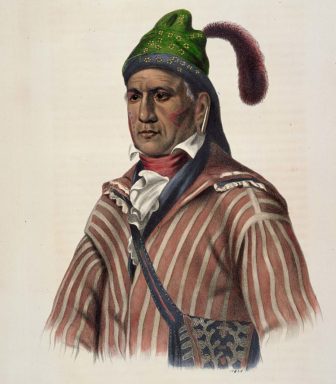Menawa: A Creek Warrior

Me-Na-Wa A Creek Warrior – Charles Bird King (1785-1862). Menawa, a Creek Warrior. Hand-colored lithograph, Plate 67. McKenney, Thomas L. & Hall, James. History of the Indian Tribes of North America. Philadelphia: F.W. Greenough, 1838-1844
As a young man, Great Warrior (Menawa), ca. 1765-ca. 1865 (Creek), was known as Crazy War Hunter in recognition of his daring military exploits and audacious horse raids.
He was a supporter of the British in the War of 1812 and opposed the cession of tribal lands to the Whites. Menawa led the group which executed McIntosh, a Creek leader who did favor cession and removal to western lands and who was condemned as a traitor. Menawa’s portrait was painted by King when he visited Washington, D.C. in 1826 to protest the 1821 treaty of cession signed by McIntosh. Although he fought in support of the United States in the Seminole War and was granted permission to remain on eastern lands, he was forced west in the 1836-1840 Removal to Indian Territory.
Menawa, first called Hothlepoya (c. 1765 – c. 1836-40), was a Muscogee (Creek) chief and military leader. He was of mixed race, with a Creek mother and a fur trader father of mostly Scots ancestry. As the Creek had a matrilineal system of descent and leadership, his status came from his mother’s clan.
He grew up among the Upper Creek in present-day Alabama and, as an adult, became part of the “Red Sticks”, a group that opposed assimilation and worked to revive traditional practices. During the Creek War (1813–1814), he led Red Sticks warriors and survived the Battle of Horseshoe Bend. To carry out punishment for the crime of an unauthorized land cession, in 1825 Menawa led about 150 lawmenders in an attack on chief William McIntosh, who had signed the Treaty of Indian Springs that year without the consent of the Creek National Council. They killed him, burned his mansion, and confiscated his property, including livestock and 100 slaves.
He was born at the village of Oakfuskee, located on the Tallapoosa River in present-day Alabama. The site is now covered by the lower part of Lake Martin, created by a dam.
His mother was a high-status Creek woman and his father a mostly Scots fur trader; such strategic alliances were common, as both cultures believed they benefited. As the Creek were matrilineal, Menawa was reared within the Creek tribe and gained his status from his mother’s clan. Her eldest brother would have acted as his mentor, teaching him men’s ways and introducing him to the men’s societies.
When Hothlepoya became the second chief of Oakfuskee, he was given the name Menawa.
During the early 1800s, he was one of the principal leaders of the “Red Sticks” or Upper Creeks, who worked to revive traditional practices and resisted assimilation to European-American ways. He emerged to lead warriors in the Creek War (1813–1814), which began as a civil war among the Creek people, where strong divisions had arisen with the Lower Creek, who comprised the majority of the population. During this period, the British were already at war against the United States during the War of 1812. They supported the Red Sticks’ resistance to United States settlers’ incursions into their territory.
Menawa was second in command of the Red Sticks at the Battle of Horseshoe Bend in 1814, when they were defeated by General Andrew Jackson commanding militias of Tennessee, Georgia and the Mississippi Territory, as well as allied Cherokee. Menawa was wounded seven times during the battle, but he escaped and survived his wounds.
